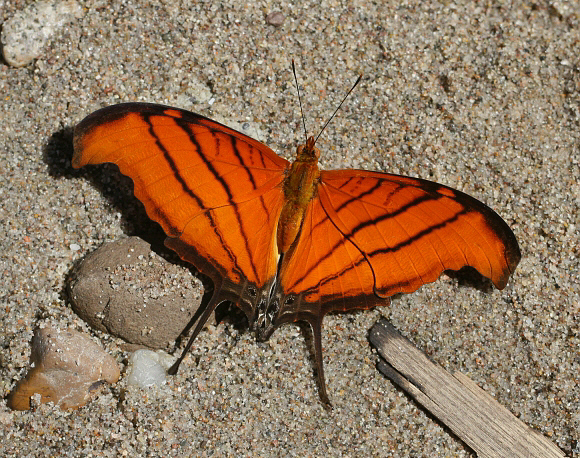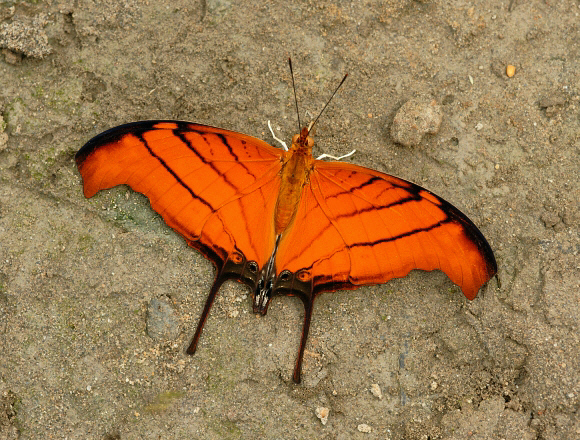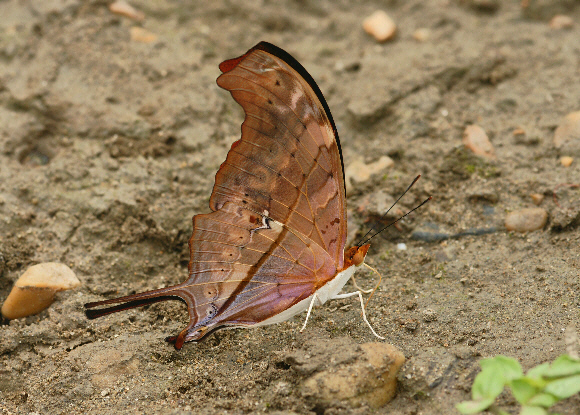 Marpesia petreus, Rio Pindayo, Peru – Adrian Hoskins
Marpesia petreus, Rio Pindayo, Peru – Adrian Hoskins
Introduction
The genus Marpesia is confined largely to the neotropical region, but is closely allied to the Mapwing and Maplet butterflies ( Cyrestis & Chersonesia ) of the Oriental region.
Daggerwings are similar in wing shape to Swordtails and Swallowtails ( Papilionidae ), but the latter have 6 legs whereas Marpesia and all other Nymphalidae genera have only 4 legs. Another feature to look for is the antennae. In all Papilionids these are recurved at the tip, but in Marpesia they are straight. In total there are 17 Marpesia species.
Marpesia petreus has a much more exaggerated wing shape than the other Marpesia species and is instantly recognisable when settled on the ground. When seen in flight however it can very easily be confused with Dryas iulia, which often occurs in the same habitats.
The Red Daggerwing, also known as the Flambeau Daggerwing or Tailed Flambeau, is distributed from Florida to Bolivia.
 Marpesia petreus, Rio Madre de Dios, Peru – Adrian Hoskins
Marpesia petreus, Rio Madre de Dios, Peru – Adrian Hoskins
Habitats
This species is found in woodland and forest habitats in tropical and sub tropical areas, at altitudes between 0-1500m. It is commonest at lower altitudes, and in deciduous forest.
Lifecycle
The eggs are straw coloured. They are laid singly on leaves of Ficus ( Moraceae ). There are also dubious records of Anacardium ( Anacardiaceae ) being used as a larval foodplant.
The larva when fully grown is multicoloured – peppered with orange, yellow and black spots, with a series of large yellow triangular markings along the sides, and a single row of 4 stiff spines along the back. The head is large, reddish in colour and adorned with a pair of very long stiff horns. The larvae feed diurnally and rest on the upperside of leaves.
The pupa is white, with squarish black markings along the sides. It bear several short black spines, and a long bifurcated spine on the thoracic hump. It is suspended by the cremaster from a stem.
 Marpesia petreus, Rio Madre de Dios, Peru – Adrian Hoskins
Marpesia petreus, Rio Madre de Dios, Peru – Adrian Hoskins
Adult behaviour
Males can be seen either singly or in small groups of up to about 6 individuals, imbibing mineralised moisture from dry river beds, sandbanks, and sometimes from forest roads. As with other Marpesia species they tend to flit from spot to spot, fanning their wings, and are nervous if approached, but if temperatures are cool they sometimes feed and bask with wings outspread. Females spend most of their lives in the canopy and are rarely seen.
Both sexes nectar at flowers of Cordia, Croton, Lantana and Mikania.
